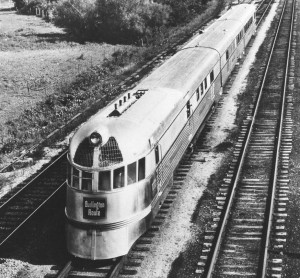In 1934, the Burlington Railroad’s new Zephyr streamliner roared through Western Springs. And, the speedometer hit 107 miles-per-hour!

Burlington’s “Pioneer Zephyr” – 1934
In June 1933, the Burlington Railroad ordered a revolutionary stainless steel, streamlined train from the Budd Manufacturing Company. It was to be powered by a diesel-electric motor built by General Motors’ Electro-Motive Division in La Grange. The train would cost $200,000 and be capable of reaching speeds in excess of 100 miles per hour.
In 1934, the railroad announced that the new train would be displayed at Chicago’s “Century of Progress” World’s Fair. But before going on display, it would demonstrate its incredible speed by traveling 1,015 miles from Denver to Chicago without stopping en route. The train would be called the Zephyr after Zephyrus, the Greek god of the West wind. After a “shakedown” run through various east coast cities, the Zephyr traveled west to Denver. Then, on Saturday, May 26, 1934, the train departed Denver for Chicago in what was billed as a “dawn-to-dusk” dash.
Due to the train’s unusually high speeds, the railroad arranged to have two men with red flags at every rail crossing between the two cities that was not protected by signal gates. All crossings were closed to vehicular traffic 15 minutes before the Zephyr passed by. In addition, the railroad installed crowd control ropes on platforms to keep spectators from getting too close to the tracks. The new train more than lived up to the hype. On one section of the run, it reached a speed of 112.5 mph, just short of what was then the U.S. land speed record of 115 mph. The entire trip took just 13 hours and 5 minutes with an average speed of 77 mph.
In Western Springs, residents began gathering around 6 p.m. in anticipation of the train’s appearance. Crowds reportedly lined both sides of the tracks, patiently awaiting the train for more than an hour. While special stanchions and ropes had been installed along the train platforms, Western Springs police and a dozen Burlington employees made sure that the crowds stayed a safe distance from the tracks. Then, according to the local newspaper, the crowds were rewarded “with the sight of a white gleaming creature speeding downward from the Hinsdale Highlands on the Burlington’s center track.”
Unlike most towns and villages along the train route, Western Springs had several residents riding onboard the train. Paul Mulkey, who lived at 4611 Grand Avenue, was a member of the Burlington engineering department that helped design the train. He and his wife were among the 50 invited guests onboard the train. In addition, Charles Breed, a Burlington executive who resided at 4803 Lawn Avenue, was on board to monitor the train’s performance. And, as the train passed through Western Springs, he was in the engineer’s compartment. According to Breed, the train’s speedometer hit exactly 107 miles per hour as it passed through our town, no doubt a village speed record.
After being displayed all summer at the World’s Fair, the Zephyr entered regular service on November 11, 1934, between Kansas City, Omaha, and Lincoln. It was subsequently named the Pioneer Zephyr and operated on this and other routes until its retirement in 1960. It was then donated to Chicago’s Museum of Science and Industry, where it remains on public display. The train is generally regarded as the first successful streamliner used on the American railroads.
